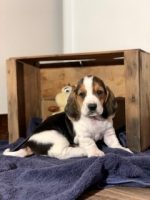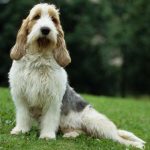 The Miniature Basset Hound
The Miniature Basset Hound
The miniature Basset Hound is a smaller version of the well-known dog breed the Basset Hound. It could be thought of as a smaller type of the Basset Hound, but it is an entirely different breed. The physical attribute that makes this dog a miniature is their weight and not their height. The miniature hound weights 10 – 35 pound when fully grown. A regular Basset Hound is typically around 45 – 65 pounds. These dogs are not a designer breed of dogs like the Labradoodle, Puggle or Schnoodle. These dogs have been properly bred by professional and experienced breeders over many years combining several different types basset breeds to create this smaller new breed of a basset.
Traits
The official name of the breed is the Parva Os Lux Basset. They have short legs and stand about 14 inches tall, but the real definitive trait is their long ears. The ears can be long, wide, skinny or any combination of the three. The preferred standard for the ears is being able to put them over the dog’s eyes, this doesn’t happen naturally and can only be discovered when you gently place the ears over the eyes. They have a short-haired coat and are typically tricolored with variances of black, brown, red, tan and white.
Because of the size differences mentioned above the miniature hound is more agile and faster. They do not need an excessive amount of exercise but should have a couple of walks each day.
Temperament
The miniature Basset Hound is a great family pet. They are very loyal and friendly. They have a very calm demeanor. They love affection and will climb into your lap. If their owner is giving attention to another dog they will get jealous by barking or trying to get you to pick them up. Much like other hound breeds, they can have selective hearing and a very strong nose. Many times these two things go hand in hand. They are great hunting dogs. Their nose will lead them on a hunt and they will decide they don’t hear you when you call for them. For this reason, they should be kept on a leash or in a fenced yard.
Another trait that makes them similar to other hound dogs is their bark. They tend to have a loud howl. This could be an issue if you live in an apartment or have an attached living space to someone else. They will bark at strangers and intruders which makes them good watchdogs, but they will rarely do anything more then bark, so they might be the best guard dog but they would alert their family if they see someone. They are also known to snore and drool a little. This mostly happens when they have just had a drink and they have a few drop drip when they are walking away from their bowl.
Health
The miniature Basset Hound has many of the same health concerns as its counterpart. They are susceptible to glaucoma, hip and/or elbow dysplasia, patellar luxation, and hypothyroidism. This, of course, is not a full list and doesn’t mean that your dog will get any one of these. The miniature Basset Hound is still under development as a breed, but there have not been any additional health-related issues than the ones of a regular Basset Hound.
These dogs do shed and will need to be groomed, but don’t seem to mind the grooming because of the attention they get while being groomed. Giving them some fish oil each week will help to decrease some of the sheddings. Some excessive shedding can be because of a lack of dietary fat so added the fish oil or olive oil will help give them a healthy coat.
 Basset hounds have a lovely, distinctive look that captures the heart of anyone who gets to meet one. They have droopy dig faces with short legs, and they are sweet and playful. If you’re interested in owning one, it’s important to understand the basset hound temperament to know what you’re getting into.
Basset hounds have a lovely, distinctive look that captures the heart of anyone who gets to meet one. They have droopy dig faces with short legs, and they are sweet and playful. If you’re interested in owning one, it’s important to understand the basset hound temperament to know what you’re getting into. Most people know about the bassets because of popular culture, notably when the dog breed appeared as a part of advertising logos. Historically, these dogs were bred to hunt for small game, including rabbits. These days, there are still parts of the country that still use the dog for such purposes. If you are searching for an active yet laidback pet that is kid-friendly, the French basset hound may be a good choice for you.
Most people know about the bassets because of popular culture, notably when the dog breed appeared as a part of advertising logos. Historically, these dogs were bred to hunt for small game, including rabbits. These days, there are still parts of the country that still use the dog for such purposes. If you are searching for an active yet laidback pet that is kid-friendly, the French basset hound may be a good choice for you.






